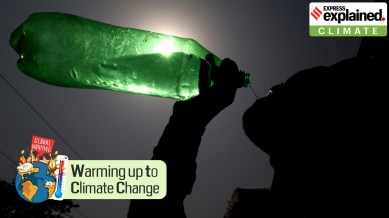Warming up to climate change: Is the Sun behind the rising global temperatures?
In this series of explainers, we answer some of the most fundamental questions about climate change, the science behind it, and its impact. In the fifth instalment, we answer the question: 'Is the Sun behind the rising global temperatures?'

Delayed snowfall in Northern India, sweltering heatwave in Australia, raging wildfires in Chile, and soaring sea surface temperatures. These are only a handful of consequences of global warming that the world is currently witnessing. Although scientists unequivocally agree that climate change is real, there are still many myths and a lot of confusion around the subject.
In this series of explainers, we answer some of the most fundamental questions about climate change, the science behind it, and its impact. In the fifth instalment (you can scroll down to the end of this article for the first four parts), we answer the question: ‘Is the Sun behind the rising global temperatures?’
How does the Sun impact Earth’s climate?
The Sun is the primary source of energy that fuels biological and physical processes on Earth. Its heat makes liquid water, helps plants to grow, and warms air that influences our weather system.
The middle-aged star doesn’t always shine at the same level of brightness, though. Scientists know that it slightly dims and brightens depending on an 11-year cycle of high and low activity due to the reversal of its magnetic poles.
According to a report by NASA, “During each cycle, the Sun undergoes various changes in its activity and appearance. Levels of solar radiation go up or down, as does the amount of material the Sun ejects into space and the size and number of sunspots and solar flares. These changes have a variety of effects in space, in Earth’s atmosphere and on Earth’s surface.”
For instance, data suggest that between the late 1800s and the mid-1900s, there was a small uptick in the amount of sunlight coming to Earth. Scientists estimate that this contributed to up to 0.1 degree Celsius of 1.0 degree Celsius of warming observed since the pre-industrial era.
So, is the Sun responsible for current global warming?
No, it isn’t the driving force behind today’s global warming. How do we know this? In the past five decades, although the planet’s average temperature has soared to new heights, the Sun’s energy output has increased or decreased by only 0.1%, according to the NASA report, published in 2019. This is one of the reasons why scientists don’t believe that the Sun is responsible for current global warming.
Another reason why scientists reject the idea that the Sun has a role in soaring global temperatures is that if the Sun’s energy output had increased, all of the layers of Earth’s atmosphere would be warming up. But that hasn’t happened.
Instead, it has been observed that the lower atmosphere is warming and the upper atmosphere has cooled in recent years — an attribute of the warming caused by greenhouse gases.
Therefore, it is safe to conclude that today’s global warming is a result of human activities. Since 1975, Earth has become hotter at a rate of roughly 0.15 to 0.20 degree Celsius per decade. The warming corresponds to the rising levels of greenhouse gases.
Here are the previous parts of the series:
Part 1: Is Earth becoming warmer?
Part 2: How do we know humans are causing global warming?
Part 3: As greenhouse gases occur naturally, why do emissions from human activities matter?
Part 4: What is the 1.5-degree Celsius threshold, and what happens when we breach it?